MARCH KEY FIGURES
 |  | Mar '05 | Feb 05 to Mar '05 | Mar '04 to Mar '05 |  |
 |  | '000 | % change | % change |  |
|  |
| Short-term visitor arrivals |  |  |  |  |
 | Trend | 473.4 | 1.1 | 11.3 |  |
 | Seasonally adjusted | 479.7 | 3.6 | . . |  |
 | Original | 504.7 | . . | . . |  |
| Short-term resident departures |  |  |  |  |
 | Trend | 386.8 | -0.2 | 11.2 |  |
 | Seasonally adjusted | 387.4 | 2.7 | . . |  |
 | Original | 378.4 | . . | . . |  |
|  |
| . . not applicable |
Visitor arrivals, Short-term
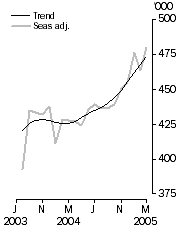
| Resident departures, Short-term
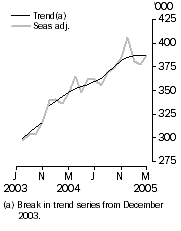
|
MARCH KEY POINTS
TREND ESTIMATES
- The trend estimate for short-term visitor arrivals to Australia during March 2005 (473,400 movements) increased by 1.1% compared with February 2005. This followed monthly increases of 1.4% for January and 1.3% for February 2005.
- Short-term visitor arrivals were 11.3% higher than in March 2004 (425,200 movements). The series last troughed in February 2004.
- During March 2005, short-term resident departures (386,800 movements) decreased marginally by 0.2% when compared with February 2005. This was the first decrease in the series since April 2003 and followed increases of 0.5% for January and 0.2% for February 2005. Monthly growth rates have slowed since the peak in growth in October 2004 (1.8%).
- Compared with March 2004 (347,900 movements) short-term resident departures were up by 11.2%.
SEASONALLY ADJUSTED ESTIMATES
- The seasonally adjusted estimate for short-term visitor arrivals during March 2005 (479,700 movements) increased by 3.6% compared with February 2005. Short-term visitor arrivals increased by 4.7% for January and decreased by 2.8% for February 2005.
- Short-term resident departures for March 2005 (387,400 movements) increased by 2.7% compared with February 2005 and followed decreases of 6.4% for January and 0.9% for February 2005.
ORIGINAL ESTIMATES
- In original movement terms, there were 504,700 short-term visitor arrivals to Australia and 378,400 short-term resident departures from Australia during March 2005.
NOTES
EARLY ESTIMATES
Early estimates of short-term visitor arrivals for April 2005 will be available on the Australian Bureau of Statistics (ABS) web site on 13 May 2005. These estimates can be accessed by going to the AusStats web page <https://www.abs.gov.au/ausstats> and selecting Publications & Data and then Main Features. Select 34 Migration and then select Short-term Visitor Arrival Estimates, Australia (cat. no. 3401.0.55.001).
DATA NOTES
This publication contains movement data. Care should be taken when interpreting this movement data as 'people'. See paragraph 5 of the Explanatory Notes for more detail.
Calculations of percentage and numeric change are based on unrounded data. See paragraph 12 of the Explanatory Notes for more detail.
CHANGES IN THIS ISSUE
Incoming passenger card - A new incoming passenger card has been notified by the Department of Immigration and Multicultural and Indigenous Affairs and was introduced by the ABS in this issue. The changes incorporated were minor and do not affect the overseas arrivals and departures data items detailed in this publication or other associated products.
EMERGING ISSUES
December 2004 Indian Ocean tsunami - The 26 December 2004 Indian Ocean earthquake and tsunami have impacted on overseas arrivals from, and resident departures to, affected countries. Quantifying the size of this impact in March 2005 overseas arrivals and departures estimates is not yet possible. For example, while seasonally adjusted short-term resident departures to Thailand have shown marked decreases for the months of January and February 2005, March 2005 has shown a return to expected levels. This event may affect the reliability of recent ABS trend estimates. The ABS will continue to monitor and report on this situation.
INQUIRIES
For further information about these and related statistics, contact the National Information and Referral Service on 1300 135 070 or Anne Ward on Canberra (02) 6252 6871.
MAIN FEATURES
SHORT-TERM VISITOR ARRIVALS
In trend terms, short-term visitor arrivals to Australia in March 2005 have increased by 11.3% when compared with March 2004. Monthly increases have been recorded since March 2004 with visitor arrivals increasing from 425,200 movements in March 2004 to 473,400 movements in March 2005.
The following table presents the top ten source countries (based on original estimates) for short-term visitor arrivals during March 2005. Seasonally adjusted and trend estimates are also presented for these countries, along with the trend percentage change compared with February 2005 and March 2004.
Short-term Visitor Arrivals, Major Source Countries - March 2005 |
|  |
 | Trend | Seasonally Adjusted | Original | Feb 05 to Mar 05 | Mar 04 to Mar 05 |  |
 | '000 | '000 | '000 | Trend % change | Trend % change |  |
|  |
| New Zealand | 91.4 | 90.5 | 91.5 | 0.8 | 11.2 |  |
| United Kingdom | 66.6 | 73.7 | 86.8 | 4.7 | 18.4 |  |
| Japan | 61.6 | 61.4 | 67.6 | -1.0 | 6.4 |  |
| United States of America | 38.5 | 38.6 | 43.6 | 2.0 | 7.8 |  |
| Singapore | 22.8 | 22.0 | 22.4 | -0.4 | 9.6 |  |
| Korea | 20.9 | 21.8 | 19.9 | 2.6 | 23.2 |  |
| China | 23.1 | (a)np | 17.4 | -2.0 | 15.5 |  |
| Germany | 12.4 | 12.7 | 14.7 | 1.1 | 8.6 |  |
| Hong Kong | 12.5 | 11.8 | 14.6 | -0.7 | 9.3 |  |
| Malaysia | 14.4 | 14.6 | 14.0 | -0.8 | 1.7 |  |
|  |
| (a) Seasonally adjusted data for short-term visitor arrivals from China is of an unpublishable standard. |
SHORT-TERM RESIDENT DEPARTURES
In trend terms, short-term resident departures have increased by 11.2% between March 2004 and March 2005. However, there was a small decrease (0.2%) between February and March 2005. Prior to this decrease consecutive monthly increases had been recorded from May 2003.
The following table presents the top ten destinations (based on original estimates), for short-term resident departures during March 2005. Seasonally adjusted and trend estimates are also presented for these countries, along with the trend percentage change compared with February 2005 and March 2004.
Short-term Resident Departures, Major Destinations - March 2005 |
|  |
 | Trend | Seasonally Adjusted | Original | Feb 05 to Mar 05 | Mar 04 to Mar 05 |  |
 | '000 | '000 | '000 | Trend % change | Trend % change |  |
|  |
| New Zealand | 71.8 | 71.7 | 82.9 | 0.3 | 10.5 |  |
| United States of America | 34.9 | 37.4 | 33.5 | 2.1 | 15.0 |  |
| Indonesia | 32.4 | 30.2 | 27.1 | 1.4 | 9.6 |  |
| United Kingdom | 31.6 | 32.3 | 26.8 | 0.6 | 1.6 |  |
| China | 19.2 | 20.0 | 21.4 | 2.7 | 42.5 |  |
| Hong Kong | 14.8 | 14.4 | 16.3 | -0.4 | 27.6 |  |
| Fiji | 16.2 | 15.7 | 15.3 | -0.7 | 18.7 |  |
| Thailand | 14.8 | 16.4 | 15.2 | -3.2 | -1.8 |  |
| Singapore | 15.9 | 15.4 | 15.1 | -0.2 | 32.2 |  |
| Malaysia | 14.2 | 13.0 | 14.6 | -0.3 | 22.0 |  |
|  |
SHORT-TERM TRAVEL - HONG KONG AND AUSTRALIA
Short-term visitor arrivals
According to trend estimates, in March 2005, the number of short-term visitor arrivals from Hong Kong represented 3% (12,500 movements) of all short-term visitor arrivals to Australia. Over the past ten years the trend has fluctuated with the series rising from a low in March 1995 (9,500 movements) to a high in January 1997 (13,500 movements). The March 2005 trend estimate for arrivals from Hong Kong fell by less than one percentage point when compared with February 2005 and rose by 9% when compared with March 2004.
HONG KONG, Short-term Visitor Arrivals

In original terms, 52% of the visitors from Hong Kong in March 2005 stated holiday as the main reason for journey, compared with 56% of all short-term visitor arrivals. The median age of visitors from Hong Kong was 37 years (39 years for all visitors) while the median intended duration of stay was 10 days for both visitors from Hong Kong and all short-term visitor arrivals.
Short-term resident departures
Trend estimates show that the number of residents departing Australia short-term for Hong Kong represented 4% (14,800 movements) of all short-term resident departures in March 2005. As with short-term visitor arrivals to Australia from Hong Kong the trend in short-term Australian residents departing to Hong Kong has fluctuated over the past ten years. Over this period the series reached its lowest point in September 2002 (11,300 movements) and its highest point in February 1997 (15,500 movements). The March 2005 trend estimate for resident departures to Hong Kong fell by less than one percentage point when compared with February 2005 and rose by 28% when compared with March 2004.
HONG KONG, Short-term Resident Departures
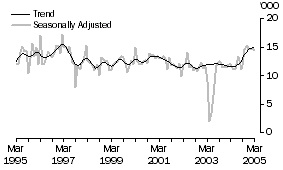
In original terms, 42% of Australian residents departing to Hong Kong stated holiday as the main reason for journey, compared with 46% for all residents departing. The median age of residents departing to Hong Kong was 44 years (42 years for all residents) and the median intended duration of stay was 11 days (14 days for all residents).
PERMANENT AND LONG-TERM MOVEMENTS
There were 11,690 permanent (settler) arrivals into Australia during March 2005, an increase of 25.3% when compared with March 2004 (9,330 movements). Settlers born in the United Kingdom accounted for the largest proportion (17%) followed by New Zealand (14%) and China (9%).
Statistics on overseas arrivals and departures relate to the number of movements of travellers rather than the number of travellers. Therefore, care should be taken when using long-term movements data as it is known some individuals who travel multiple times in a year are counted each time they cross Australia's borders (see paragraph 5 of the Explanatory Notes). Long-term movements in this publication are not an appropriate source of migration statistics. For further information refer to Australian Demographic Statistics (cat. no. 3101.0).
There were 5,330 Australian residents departing permanently from Australia during March 2005, an increase of 2.8% when compared with March 2004 (5,180 movements).
STATISTICAL SIGNIFICANCE
The above presentation of movements in estimates does not take into account whether the change in movement is statistically significant. Care should be taken when interpreting the impact of numeric and/or percentage change. Please see the Standard Errors section of this issue for more detail.
SEASONALLY ADJUSTED AND TREND ESTIMATES
INTRODUCTION
Seasonally adjusted and trend estimates add to the understanding of Overseas Arrivals and Departures (OAD) statistics. Seasonally adjusted estimates allow users to analyse short-term movements including irregular impacts on the series, while trend estimates provide a better method to analyse and monitor the underlying direction of the short-term movement series. In most cases, the trend series is the best source of information on the long-term direction of these statistics.
SHORT-TERM VISITOR ARRIVALS
Selected source countries
The graphs presented below illustrate the recent increases in arrivals from the United Kingdom and the significant impact of Severe Acute Respiratory Syndrome (SARS) on arrivals from Japan earlier in 2003.
United Kingdom
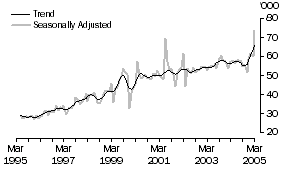 Japan
Japan

SHORT-TERM RESIDENT DEPARTURES
Selected destinations
For residents departing to the United States of America the graph illustrates the effect that the terrorist attacks in that country on 11 September 2001 had on short-term departures of Australian residents to the United States of America. The graph for New Zealand illustrates that departures of Australian residents have been trending upwards since May 2003.
United States of America
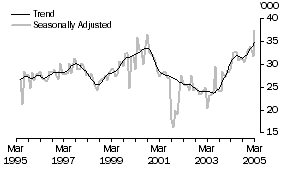 New Zealand
New Zealand
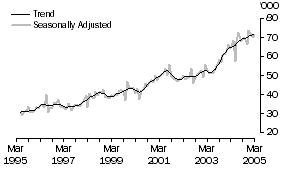
 Print Page
Print Page
 Print All
Print All